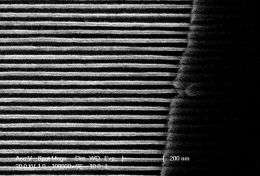November 26, 2008 feature
High-Temp Superconducting Nanowire System is First of its Kind

(PhysOrg.com) -- Scientists from the California Institute of Technology have, for the first time, created an array of nanowires that are superconducting at relatively high temperatures. This work, published recently in Nano Letters, could lead to the incorporation of superconducting nanowires into emerging nanotechnologies.
Researchers around the world have been working to create superconducting nanowires, but few studies have investigated the feasibility of nanowires made of high-critical-temperature (high-Tc) superconducting materials and, prior to this work, no such nanowires had been produced.
"We did not know whether high-Tc superconductivity could be maintained for very long, thin nanowires or whether their behavior would follow traditional superconductor models," said CalTech chemist James Heath, the paper's corresponding author, to PhysOrg.com.
He added, "High-Tc materials as nanostructures are also notoriously difficult to fabricate because their crystal structure and other properties must be maintained, and this is not easy to do."
High-Tc materials are often more desirable than traditional superconductors because they function at temperatures "warmer" than the boiling point of liquid nitrogen, or 77 degrees Kelvin (about -321 degrees Fahrenheit). While still ultra-cold by everyday standards, these temperatures are easier to achieve in the laboratory because liquid nitrogen, which is commercially available and relatively easy to work with, can be used to cool them. This makes high-Tc materials more suitable for many applications.
Despite the roadblocks, Heath and colleague Ke Xu created high-Tc nanowires using a widely known high-Tc material, a copper-oxide compound known as YBCO. The nanowires were fabricated from YBCO strips into arrays of up to 400 nanowires each, lined up in parallel. Metal contacts run across the wires perpendicularly so that their electrical properties could be measured.
The wires are as narrow as 10 nanometers and as long as 200 micrometers (millionths of a meter). The critical temperature, the temperature below which a material superconducts, varies with the wires' dimensions. For example, while all the wires exhibit a superconducting transition above liquid-nitrogen temperature, the temperature width of the transition broadens as the nanowires' widths decrease. For example, the 10 and 15 nanometer wide wires become fully superconducting 20 K and 10 K, respectively.
Because of this increased transition width, Heath and Xu's high-Tc nanowires exhibit both superconducting and normal resistive behavior over a wide temperature range—greater than 50 K. This feature could be useful in nanowire-based superconducting quantum-interference devices, or SQUIDs, in which resistance oscillations caused by quantum interference between two wires is used to measure extremely small magnetic fields.
In future work, Heath and Xu are designing nanomaterials to potentially increase the "critical current" of the high-Tc nanowire systems—the point at which the current is too high to pass through the material with no resistance.
Citation: Nano Lett., 2008, 8 (11), pp 3845–3849
Copyright 2008 PhysOrg.com.
All rights reserved. This material may not be published, broadcast, rewritten or redistributed in whole or part without the express written permission of PhysOrg.com.





















